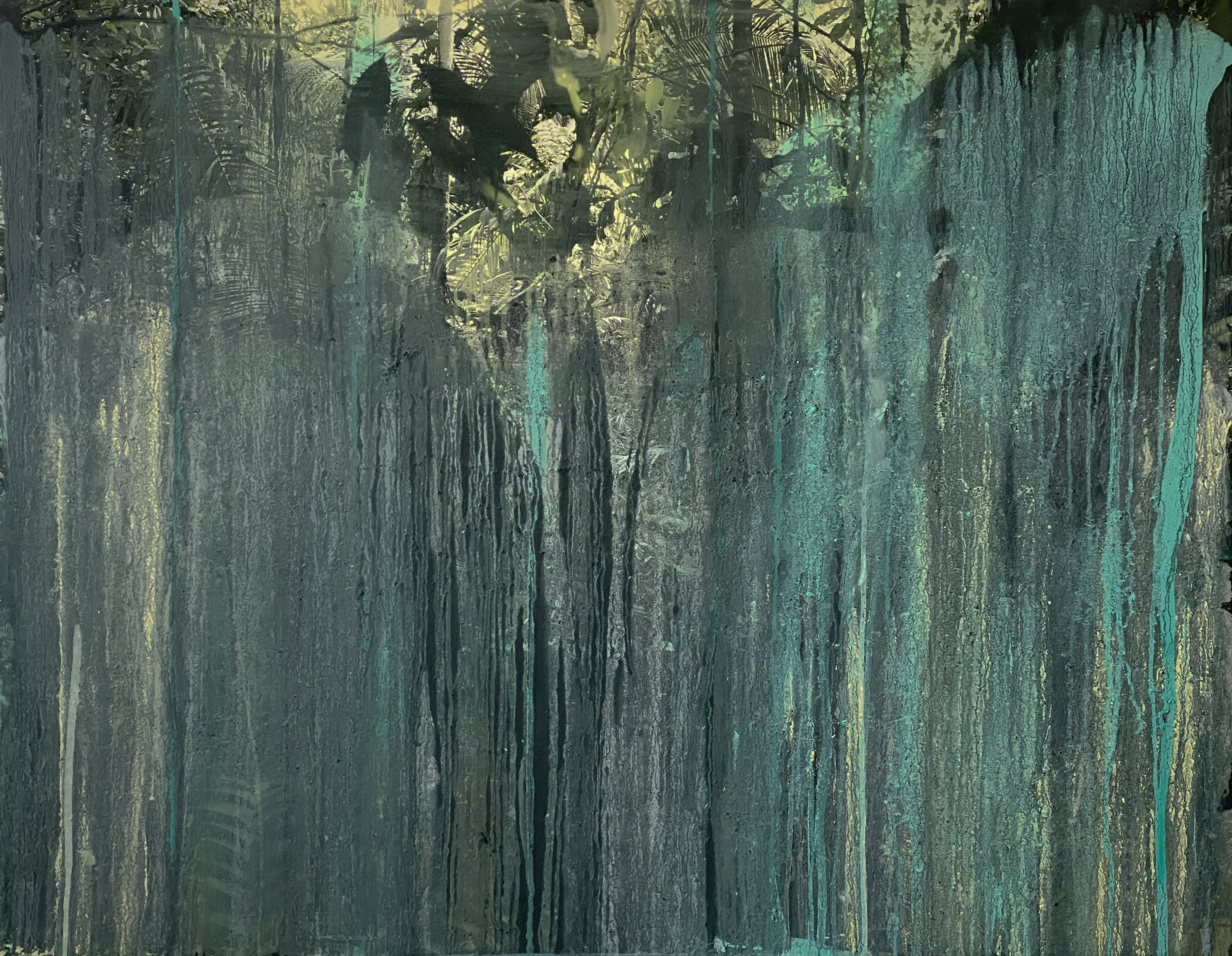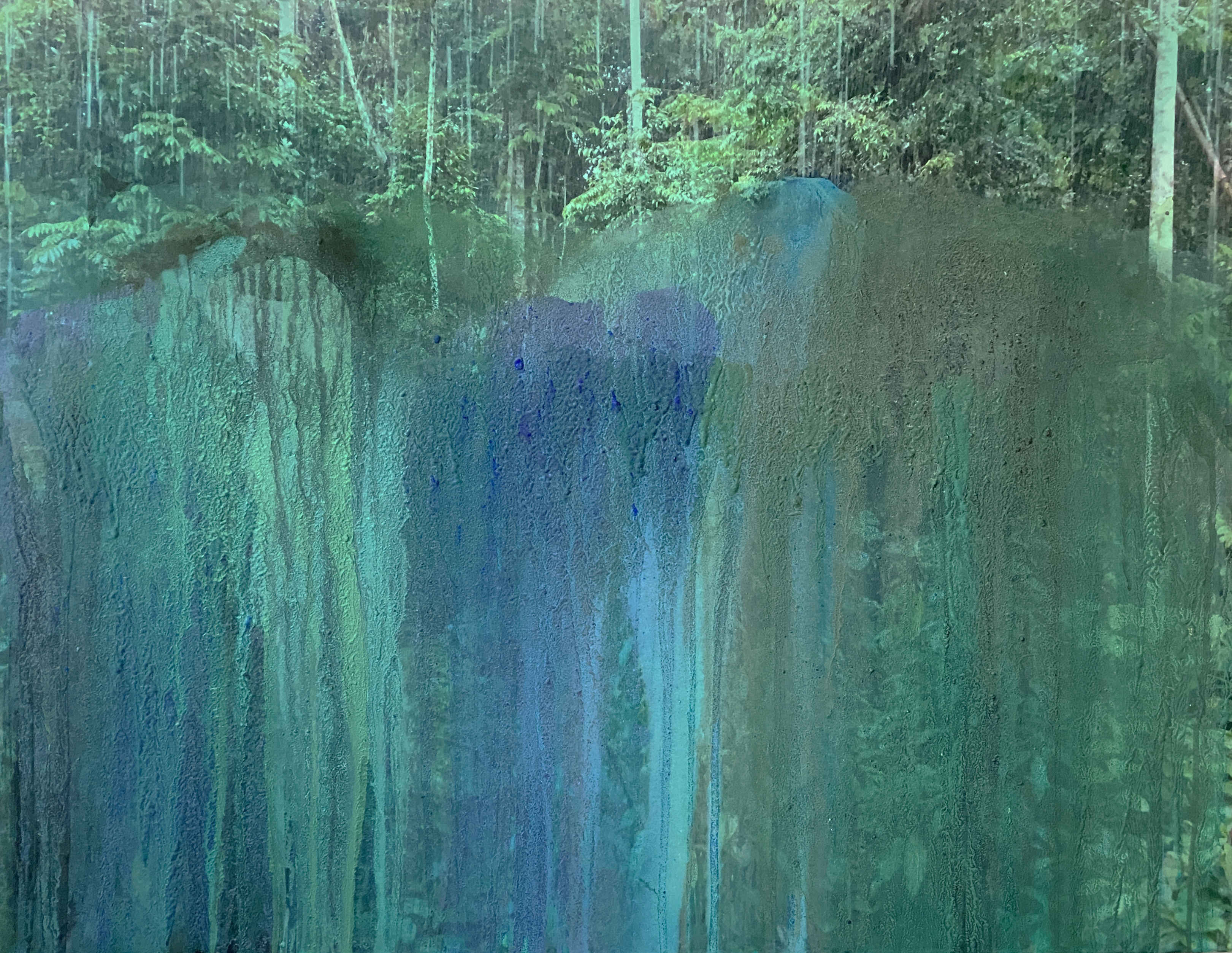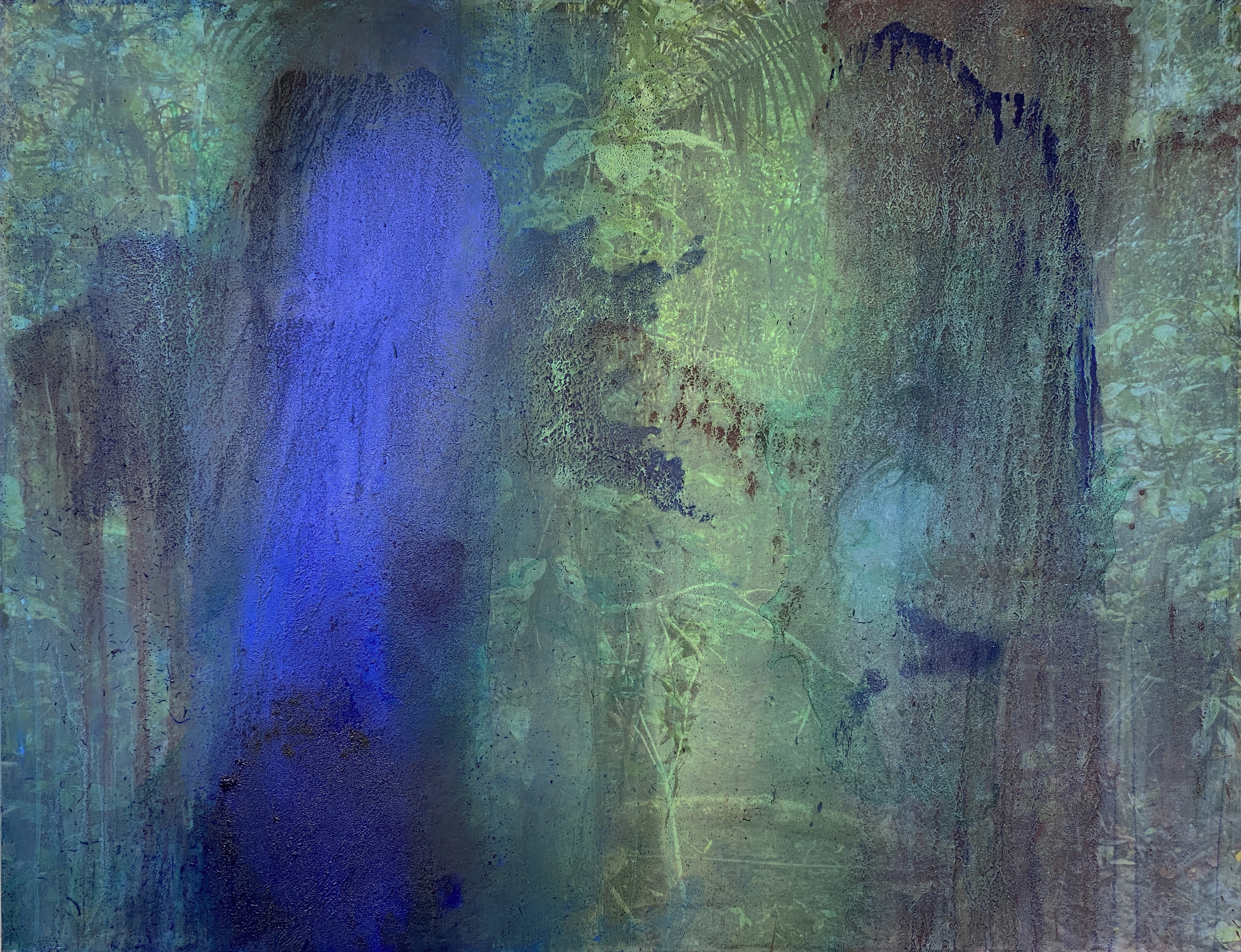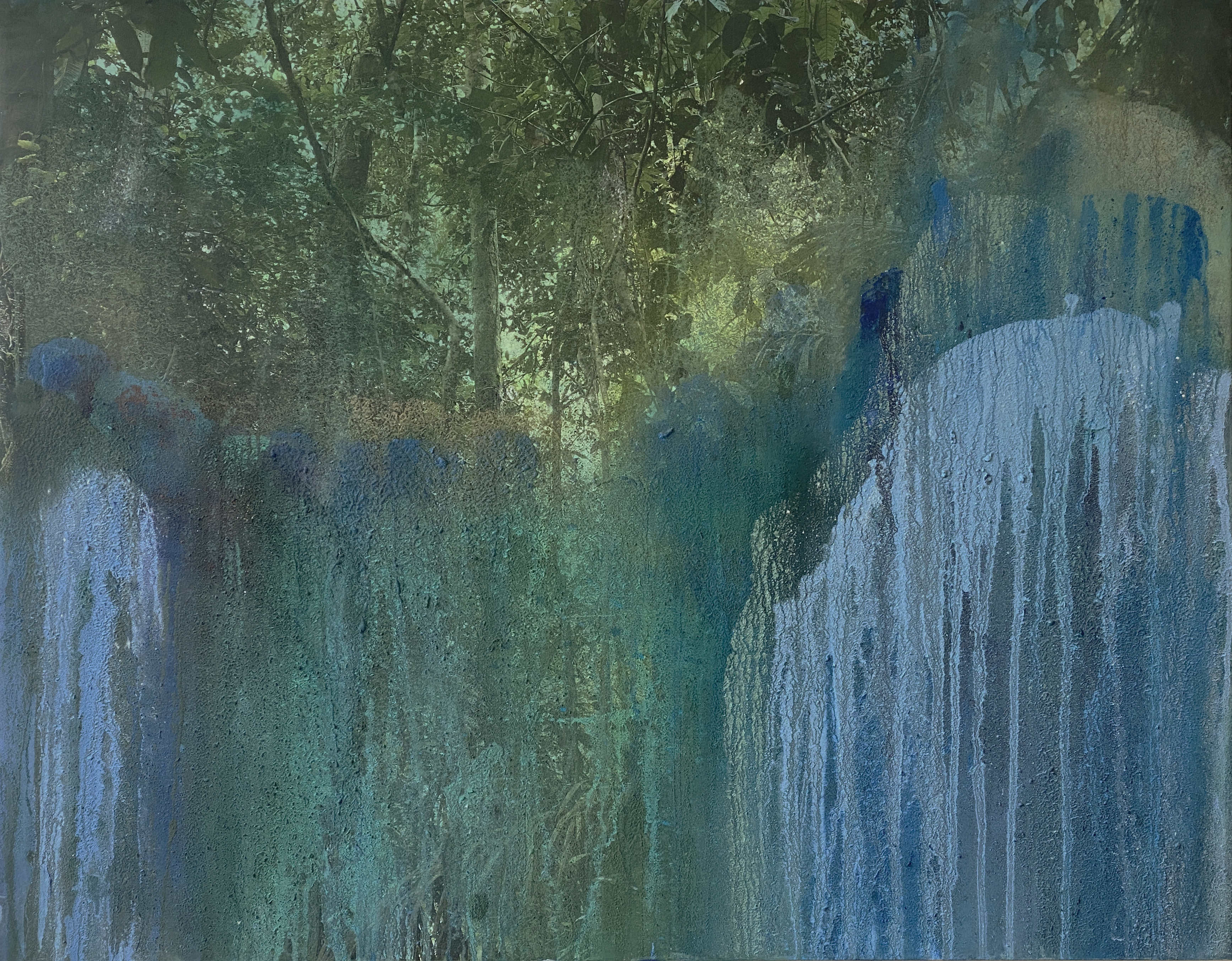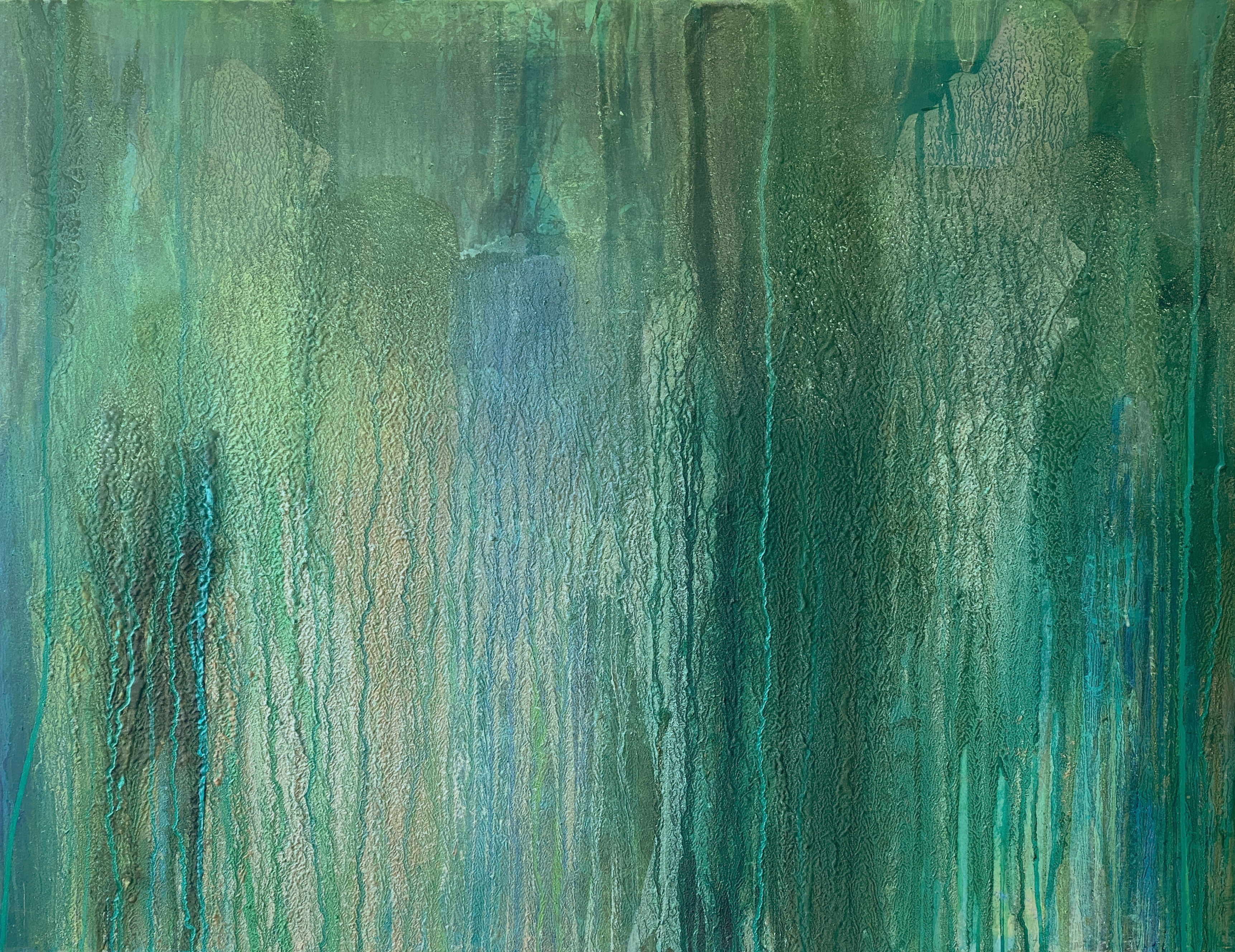..”the loss of every tree — to deforestation or to other causes — equals the passing away of meaning bound up with the particular spatial extension of that very tree , which we can no longer afford.” Michael Marder
FOREST
These works come from a time when I was intensely immersed in a forest for a month, in a window free lodge at all times exposed to the changing light, sounds, rain, creatures and of the forests expressions. I lived and breathed it. The movement of night into dawn to the racket of evening tending back to night were never outside of my awareness. The forest was part of the Madres de Dios in the Peruvian Amazon, an area of Primary rainforest where I stayed from December 2015 to January 2016 on a Trelex art residency. The forest still resides within me and I find myself returning over and over again to strangeness, fear, wonder and sensuous delight walking through the trees and undergrowth. I pour over the hundreds of photographs and films I made and the works on paper that are the basis of these paintings.
The extended time spent primary rainforest afforded a rich encounter with one of the most dense and varied ecospheres on earth. Michael Marder reminds us that there is more plant life than anything else in our world. “A biomass of green – the largest mass on the planet.” At no time, however, are you not simultaneously aware of how in those very moments it is being diminished and contaminated by human destruction and extraction.
I tried always to meet the forest in reverie and openness. ‘Open the whole of your sensorium to the other beings’ As David Abram puts it. I was strongly drawn to the forest and being in it always felt the most important thing. Even when I was involved with art work, this seemed less relevant than simply being in the forest. Moving through it.
These paintings are partial outcomes of this encounter. In talking of these encounters I reference the work of two contemporary philosophers, David Abram and Michael Marder.,
David Abrams an American ecologist and philosopher best known for his work bridging the philosophical tradition of phenomenology with environmental and ecological issues.
Michael Marder works in the phenomenological tradition of Continental philosophy, environmental thought, and political philosophy. His philosophical work has focused on building philosophies that take into account plants as beings with their own form of subjectivity
DAVID ABRAM
Abram tries to find new ways to think within rather than separate from the ‘More than human world world’ his terminology for the natural world with all its lives and phenomena, in which we live. And the ways that we can connect to it in a kind of biofeedback loop.
From a phenomenological perspective where perception can be seen as a form of participation he talks of how:
“an ecology of perception connects us via sensory experience (and) functions to bind our individual nervous systems into the encompassing eco system.”
“When I gaze at another creature. My nervous system is synapsed through my senses to its nervous system. So my awareness is in direct contact with its awareness…….Perception is an ongoing improvisation between my body and the bodies of other beings.”
“Touching things, I am being touched, by gazing out, also being seen.”
“My senses are part of a whole system of communication like tree roots reaching out.”
“Eyes are part of the visible field. Gazing out at these trees, I’m also feeling myself seen from their perspective.” Obviously trees don’t have eyes in the way that we do but: “Trees are responding to light and shadow all the time, highly photoreceptive beings.”
He describes his aim as:
“Working out the thinking ways of speaking under the influence of the more than human earth…..Looking to write in such a way that opens the human mind back onto the larger mind.”
Which resonates as close to my intention with the paintings.
Although I also encountered animals, the paintings are more about the vegetal; the world and life force of trees and plants. Here I turn to Michael Marder whose work centres on a new found emphasis on the intelligence, agency and expressivity of plants as well how we can find the vegetal in us. How it exists as a residue in our thinking and being. He reminds us that we were vegetal first, from our evolutionary origins and then we co-evolved with plants. Our DNA is to this day 50% the same, for example, as trees.
MICHAEL MARDER
“Humans share intelligence and life with plants, from which much of our own thinking and being drive.”
“not all language unfolds in words; gestures and living bodies speak as well, even in the way they inhabit places.”
“We escape into the plant world from which we have been fleeing for millennia now. And it is tremendously difficult to undo the effects of this flight that have come to define our culture itself. Nothing less will do than reversing the direction of culture and reconceiving it as a loving cultivation of the vegetal world and of the living.”
“we must cultivate a different culture, staring from a drastically new relation to plants.”
“If we wish to discover vegetal mindfulness in ourselves, we should look no further than our bodies’ unconscious attention to the surroundings. Like the leaves of plants, our skin senses humidity and temperature, light gradients and vibrations.”
As he says about the beech forests in his locale :”I have learned to recognise myself in them, to draw meaning and organise my world around them”
At the same time he acknowledges their radical otherness: ‘How is it possible for us to encounter plants? And how can we maintain and nurture, without fetishizing it, their otherness in the course of this encounter?
“All we can hope for is to brush upon the edges of their being,”
He draws parallels with vegetal being and creative process in humans.
“Plants have a lot in common with the artistic process. Plants constantly create and recreate themselves; they’re the performers of their own existence”.
“If language is more than about vocalisation – i.e. If it is about expression – then plants and animals express themselves, even spatially, by assuming particular postures or positions. In the human world, we talk about body language for example…. They have perfected body language. In fact, they can reconfigure and regrow it all the time.”
With the paintings – there is a desire for a kind of sensory expressivity which is achievable through interacting with art materials, and this interaction activates intelligences on all sorts of levels, beyond the merely conscious, cerebral and verbal. Although words can arise from the unconscious too. Marder thinks of the unconscious, unlike Freud, – as residing on the skin, and is most akin to a vegetal way of being. Simply relating to the world without deliberate thought.
“I think that, if anything, vegetal consciousness resides on the surface and we simply do not notice it. It’s so much a part of ourselves, so integral to our lives that we no longer pay attention to it. It’s almost like skin – both bodily skin and the psychic skin…..The skin is, thus, the most vegetal of our organs,”
FROM INSIDE THE PLANT
Some of the paintings are called ’Mind of Plant’ because I had this idea that they were about being inside the plant looking out onto the rest of the forest. This is obviously a speculation and a fiction, you cannot enter the mind of a plant. I am imagining myself into the being of a plant and playing with that narrative.
It sounds strange but I hope will make some sense in relation to the ideas of Marder and Abram.
It is also a narrative of immersion and engagement. Pouring natural substances such as clay and sand as well as colour onto the canvases and watching and facilitating the alchemical properties and nature within them move and unfurl organically. Then bringing it together to become something, fuse it into a image, itself mutable and transient – the paintings look almost unrecognisably different in varied lights.
The verticality of the flow of the materials echoes the sense of downward falling rain, such a visceral and persistent presence in the forest. This vertiginous ‘fall’ also resonates with ideas of our fall from grace, loss of ground (the earth) and the grieving fall of human tears.
GREEN AND BLUE
During work I mainly reached for the colours viridian green and ultramarine blue, the Klein blue of Morpho butterflies that appear in the rainforest. Although these colours were then modified and changed, they were my starting point. Both colours seem unworldly in so far as they rarely exist in nature. The colours I was drawn to were not the ones of the forest I encountered, which unless you see the canopy from above, are fairly monochrome as you are walking in the undergrowth in relative dark. The textures and shapes are usually more compelling. Layerings of green (or diversions from green) are to suggest a deep, something even watery, immersion.
Morpho Butterfly near the Palm Swamp
BEAUTY
The enormous beauty of the rainforest cannot be disregarded. Nature is throwing beauty at us all the time and yet we are high handed about it, entitled, and casually dismiss and trivialise it, especially within certain discourses around art. It is a word with much baggage which perhaps needs reframing to be useful in a contemporary context. I prefer to think of it as a force field with an extraordinary connective function that arrests us and pulls us into an exchange, the purpose and meaning of which we are drawn to question. In painting there can be an inhabiting of the non-verbal logic of the ‘beauty’ forcefield and a tussling inside of it through the manipulation of materials, with the hope that the engagement coalesces into something resonant.

